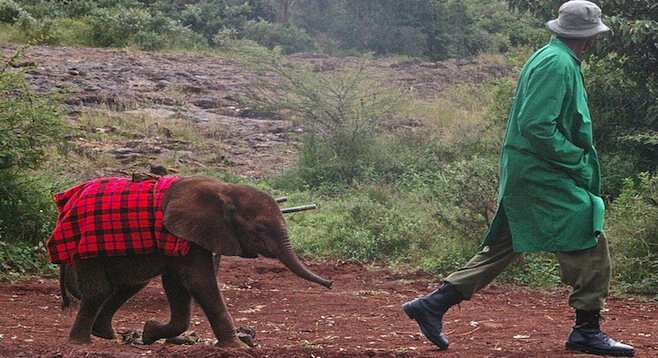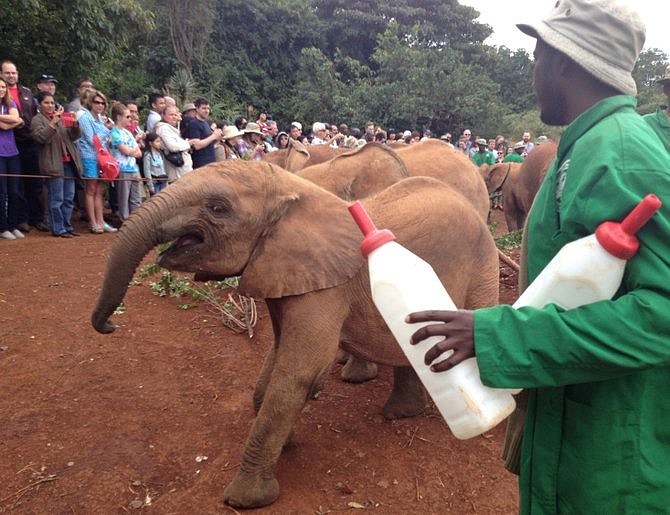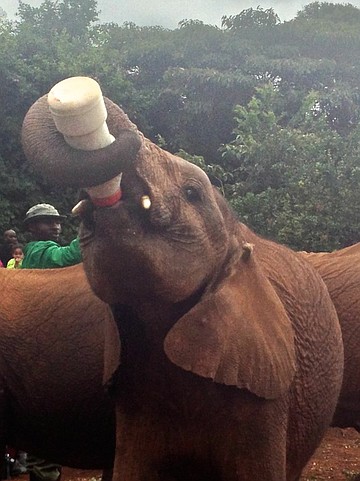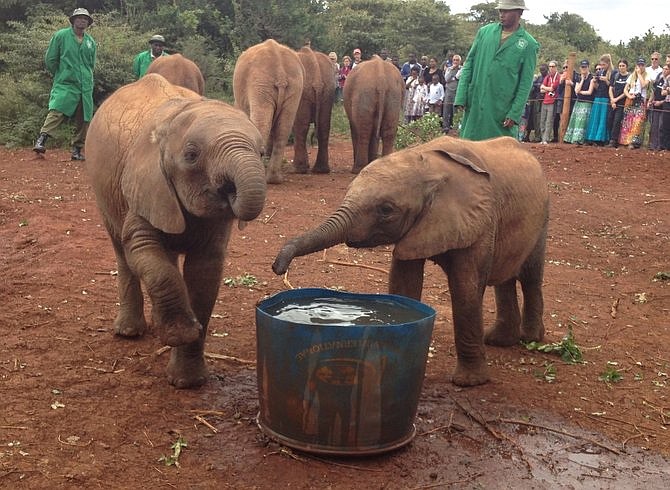 Facebook
Facebook
 X
X
 Instagram
Instagram
 TikTok
TikTok
 Youtube
Youtube

Greater Nairobi, home to more than six million people, has a reputation for mayhem. Its international airport just burned; the Kenyan capital’s nickname is Nairobbery. But visitors can still find some extraordinary pleasures.
Ranking high among them is a visit to what’s perhaps the most remarkable nursery for baby elephants on earth. The David Sheldrick Wildlife Trust leases land within Nairobi National Park (itself a big attraction – home to abundant East African wildlife living against a backdrop of skyscrapers.)
Dame Daphne Sheldrick established the trust in 1977 in honor of her husband, who had been the anti-poaching warden at Kenya’s Tsavo National Park. The formidable Daphne (and, now, David’s and her children) have carried on the work of rearing baby elephants whose mothers were killed – most often for their tusks.

Illegal traffic in bloody ivory continues to be a huge problem, perhaps worse today than it's been for a while due to official corruption in Kenya and Tanzania. A small army of elephant orphans need foster care. The Sheldricks years ago solved one huge problem by developing a formula the animals could tolerate. While cow's milk gives them fatal diarrhea, they can thrive on a variant of human baby formula. Each animal needs a lot of it: some 6-12 pints every three hours around the clock.

During the days, each baby, under the watchful eye of a tender, is free to range into the national park. Around the age of five, the youngsters move to an advanced facility where they can venture out to begin spending time with various groups of wild elephants. Once they find a group that's a good fit, they begin independent lives in the wild. The elephants decide when they're ready to make this move, and with whom.
Until they do, it costs about $900 per animal per month to support the ambitious operation. The Sheldricks have to raise all the money from private donors. One source of income comes from the 500 shillings ($6) entry fee they charge visitors to the facility, open daily but only for one hour – from 11 a.m. to noon.
On a recent visit, I arrived about 45 minutes early and grabbed a seat on a bench near the rope admissions barrier; other tourists soon were streaming in. When the guards finally released the rope, a crowd of several hundred people had massed. A pathway led to a clearing with a small muddy pool in the center. Around the pool, giant milk bottles were positioned. Everyone pressed close to the encircling rope barrier, a prime position for watching an attendant emerge from the thick bush, walking next to a tiny elephant (top) – just two and a half months old, we later learned. A bright red Maasai blanket covered the sensitive skin on her back.
I think human babies are cute. So are puppies. But in the Cosmic Cuteness competition, baby elephants arguably leave them both in the dust. Tiny, hairy, with oversized ears, and long, long eyelashes, this little female was named Mystery (in Swahili) because she'd been found when she was just three days old, in good health but lying in the middle of an airstrip with no trace of her mother.
She guzzled the milk from the bottle held by her human attendant, then stroked him delicately with her little trunk, provoking a concert of cooing. It came from the kids, women, and men who had traveled here from all over the globe. Everyone looked spellbound.

The pachyderm-human love fest continued as more attendants led in a dozen more of the big babies for their feeding. There were comic moments, as when one little guy rushed up to his bottles, knocked them over, then trumpeted with amazing volume in his impatience to be fed.
Another rambunctious character thought it funny to bump into the crowd, pressing up against the rope, and provoke shrieks and howls of laughter. Yet another baby, after feeding, played with a shovel in the enclosure, balancing the tool on its hairy head. There was pathos too, as a narrator/attendant introduced each orphan, detailing what had brought each to the center. So much murder and heartache – for the sake of tchotchkes.
With education and public pressure, elephant lovers can hope the Asian appetite for ivory will dry up (and maybe sooner rather than later; Dame Daphne's 2012 autobiography reportedly is being translated into Mandarin and Cantonese). But other forces also threaten the world's elephants and other great wild animals, most prominently the ravenous human appetite to exploit the wildernesses needed to support wildlife. When you see warriors like the Sheldricks fighting to protect and nurture the elephants, the battle feels epic.


Greater Nairobi, home to more than six million people, has a reputation for mayhem. Its international airport just burned; the Kenyan capital’s nickname is Nairobbery. But visitors can still find some extraordinary pleasures.
Ranking high among them is a visit to what’s perhaps the most remarkable nursery for baby elephants on earth. The David Sheldrick Wildlife Trust leases land within Nairobi National Park (itself a big attraction – home to abundant East African wildlife living against a backdrop of skyscrapers.)
Dame Daphne Sheldrick established the trust in 1977 in honor of her husband, who had been the anti-poaching warden at Kenya’s Tsavo National Park. The formidable Daphne (and, now, David’s and her children) have carried on the work of rearing baby elephants whose mothers were killed – most often for their tusks.

Illegal traffic in bloody ivory continues to be a huge problem, perhaps worse today than it's been for a while due to official corruption in Kenya and Tanzania. A small army of elephant orphans need foster care. The Sheldricks years ago solved one huge problem by developing a formula the animals could tolerate. While cow's milk gives them fatal diarrhea, they can thrive on a variant of human baby formula. Each animal needs a lot of it: some 6-12 pints every three hours around the clock.

During the days, each baby, under the watchful eye of a tender, is free to range into the national park. Around the age of five, the youngsters move to an advanced facility where they can venture out to begin spending time with various groups of wild elephants. Once they find a group that's a good fit, they begin independent lives in the wild. The elephants decide when they're ready to make this move, and with whom.
Until they do, it costs about $900 per animal per month to support the ambitious operation. The Sheldricks have to raise all the money from private donors. One source of income comes from the 500 shillings ($6) entry fee they charge visitors to the facility, open daily but only for one hour – from 11 a.m. to noon.
On a recent visit, I arrived about 45 minutes early and grabbed a seat on a bench near the rope admissions barrier; other tourists soon were streaming in. When the guards finally released the rope, a crowd of several hundred people had massed. A pathway led to a clearing with a small muddy pool in the center. Around the pool, giant milk bottles were positioned. Everyone pressed close to the encircling rope barrier, a prime position for watching an attendant emerge from the thick bush, walking next to a tiny elephant (top) – just two and a half months old, we later learned. A bright red Maasai blanket covered the sensitive skin on her back.
I think human babies are cute. So are puppies. But in the Cosmic Cuteness competition, baby elephants arguably leave them both in the dust. Tiny, hairy, with oversized ears, and long, long eyelashes, this little female was named Mystery (in Swahili) because she'd been found when she was just three days old, in good health but lying in the middle of an airstrip with no trace of her mother.
She guzzled the milk from the bottle held by her human attendant, then stroked him delicately with her little trunk, provoking a concert of cooing. It came from the kids, women, and men who had traveled here from all over the globe. Everyone looked spellbound.

The pachyderm-human love fest continued as more attendants led in a dozen more of the big babies for their feeding. There were comic moments, as when one little guy rushed up to his bottles, knocked them over, then trumpeted with amazing volume in his impatience to be fed.
Another rambunctious character thought it funny to bump into the crowd, pressing up against the rope, and provoke shrieks and howls of laughter. Yet another baby, after feeding, played with a shovel in the enclosure, balancing the tool on its hairy head. There was pathos too, as a narrator/attendant introduced each orphan, detailing what had brought each to the center. So much murder and heartache – for the sake of tchotchkes.
With education and public pressure, elephant lovers can hope the Asian appetite for ivory will dry up (and maybe sooner rather than later; Dame Daphne's 2012 autobiography reportedly is being translated into Mandarin and Cantonese). But other forces also threaten the world's elephants and other great wild animals, most prominently the ravenous human appetite to exploit the wildernesses needed to support wildlife. When you see warriors like the Sheldricks fighting to protect and nurture the elephants, the battle feels epic.
Comments